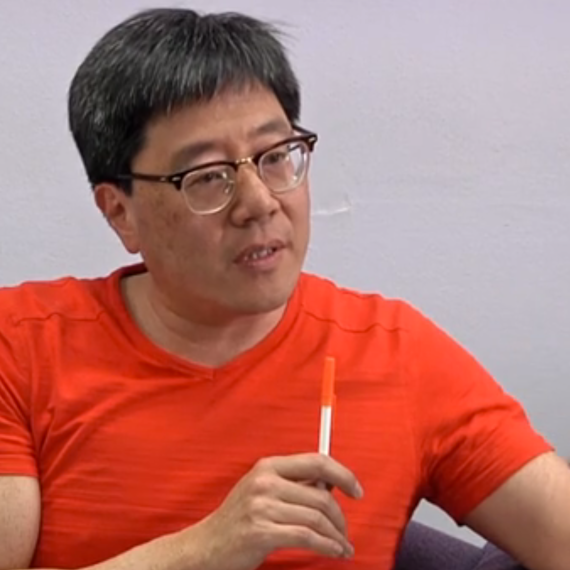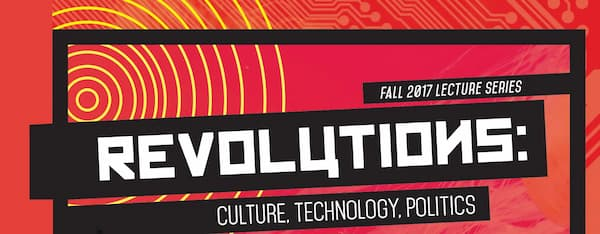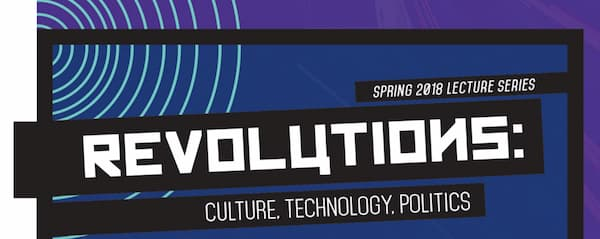Contact Us
Battelle-Tompkins, Room 200 on a map
CAS Dean's Office 4400 Massachusetts Avenue NW Washington, DC 20016-8012 United States2017-18: Revolutions
Our investigation for this year is anchored by two anniversaries of important historical and cultural events: the 100 years of the Russian Revolution in October 1917, and the 200 years of the publication of Mary Shelley’s Frankenstein in January 1818. Our lectures focus on political transformation, technological bodies, revolution, perception, and art.
The Fall 2017 series featured
-
Arthur Shapiro, Revolutionizing Perception, September 20
- Michael Sappol, Body Modern: Fritz Kahn, Medical Illustration and the Visual Rhetoric of Modernity 1915-1960, October 4
- Eric Lohr, 100 Years Ago Today: The Russian Revolution, October 25
- Catherine Knight Steele, Black Joy and Resistance: Black Feminist Discourse Online, November 8, 2017
The Spring 2018 series featured
- Richard Sha Presents Romantic Science, February 7
- Jimena Canales, Metastable Demons: The Otherworldly Operators of the 20th Century, March 7
- Oliver Gaycken, Digital Complexity: On the Circulation of Special Effects, April 4
Fall 2017

Arthur Shapiro, Revolutionizing Perception
September 20, 2017
Have you ever seen the Duck-Rabbit illusion? It is an image that people see and interpret differently, sometimes seeing the rabbit, sometimes the duck, sometimes both at the same time. Philosopher Ludwig Wittgenstein used this image to describe the problem of perception as “seeing that” (“It’s a rabbit”) and “seeing as” (“I see this picture as a rabbit”). In this accessible and fun lecture, Artur Shapiro will explore the difference between what we see and how we understand and interpret what we see, by using examples from his current laboratory research and award winning visual illusions.
About Arthur Shapiro
Arthur Shapiro completed his undergraduate work in Mathematics (Computer Science) and Psychology (Cognitive Science) at U.C. San Diego. He received his Ph.D. in Psychology from Columbia University and did post-doctoral research at the University of Chicago in the Department of Ophthalmology and Visual Sciences. He has been interested in illusions ever since his parents first took him to a science museum. He started producing research related to illusions in 2002, following a sabbatical year at the University of Cambridge. In addition to his research, Shapiro is currently co-editing The Oxford Compendium of Visual Illusions. In addition to being an academic, Shapiro is also a vision scientist and an internationally acclaimed creator of visual illusions. Many of his illusions have won awards in the “Best Visual Illusion of the Year” contest, sponsored by the Neural Correlate Society. The contest started in 2005, and since then Shapiro’s lab has produced twelve illusions in the top ten, and six illusions in the top three—more than any other researcher or research team. The National Geographic show Brain Games has featured several of Shapiro’s illusions
Michael Sappol | Body Modern:
Fritz Kahn, Medical Illustration and the Visual Rhetoric of Modernity 1915-1960
October 4, 2017
A poster first printed in Germany in 1926 depicts the human body as a factory populated by tiny workers doing industrial tasks. Devised by Fritz Kahn (1888–1968), a German-Jewish physician and popular science writer, “Der Mensch als Industriepalast” (or “Man as Industrial Palace”) achieved international fame and was reprinted, in various languages and versions, all over the world. It was a new kind of image—an illustration that was conceptual and scientific, a visual explanation of how things work—and Kahn built a career of this new genre.
In this lecture, Michael Sappol will offer his analysis of Fritz Kahn, his visual rhetoric, and the relationship between conceptual image, image production, and embodied experience.
Kahn and his artists created playful new visual tropes and genres that used striking metaphors to scientifically explain the “life of Man.” This rich and largely obscure corpus of images was a technology of the self that naturalized the modern and its technologies by situating them inside the human body. The scope of Kahn’s project was vast—entirely new kinds of visual explanation—and so was his influence. Today, his legacy can be seen in textbooks, magazines, posters, public health pamphlets, educational websites, and Hollywood movies. But, Sappol argues in his latest book, Body Modern, Kahn’s illustrations also pose profound and unsettling epistemological questions about the construction and performance of the self. Join us for this insightful and unique lecture to learn more about the impact and importance of Kahn’s illustrations.
About Michael Sappol
Michael Sappol lives in Stockholm, Sweden and is a visiting researcher at the Swedish Collegium for Advanced Study in University of Uppsala. For many years he was a historian, exhibition curator and scholar-in-residence in the History of Medicine Division of the National Library of Medicine (USA). Sappol’s work focuses on the history of anatomy, death, and the visual culture of medicine and science in film, illustration and exhibition. He is the author of A Traffic of Dead Bodies (2002) and Dream Anatomy (2006), editor of A Cultural History of the Human Body in the Age of Empire (2010) and Hidden Treasure (2012), and formerly curator of Medical Movies on the Web. His most recent book is Body Modern: Fritz Kahn, Scientific Illustration and the Homuncular Subject (University of Minnesota Press, 2017). Sappol is currently working on two new books, “Anatomy’s photography: Objectivity, showmanship and the reinvention of the anatomical image, 1860-1950” and “Queer anatomies: Perverse desire, medical illustration and the epistemology of the anatomical closet.”
Eric Lohr | 100 Years Ago Today:
The Russian Revolution
October 25, 2017
Join us for a lecture by Eric Lohr (Department of History, American University) on the 100 years since the Russian revolution of 1917. How have the meanings of socialism changed over the course of this century? And what can the Bolsheviks teach us about the structure and impact of revolutions?
About Eric Lohr
Eric Lohr is Chair of the History Department at American University and is widely recognized as one of the leading scholars of Russia’s World War I experience, authoring many articles and document publications on the subject. He previously taught at Harvard as an assistant professor of History (2000-2003). He is the author of Russian Citizenship: From Empire to Soviet Union (Harvard University Press, 2012) and Nationalizing the Russian Empire: The Campaign Against Enemy Aliens during World War I (Harvard University Press, 2003). He is also the co-author of a book with Lafayette College history professor Joshua Sanborn titled Russia’s Great War, 1914-1918, and is the editor of the forthcoming book The Empire and Nationalism at War. He is currently writing Russia’s War, 1914-1918: From Total Mobilization to Total Demobilization.
Catherine Knight Steele | Black Joy and Resistance: Black Feminist Discourse Online
November 8, 2017
Dr. Steele’s latest project, and the topic of this lecture, is on digital black feminism and how the affordances of new media technology are shaping black feminist discourse online. She provides critical analysis of the digital culture of black and white feminist thought in the blogs Jezebel and For Harriet, by examining what happens when the subject, the black body, at least temporarily does not exist as an ‘other’ but is squarely within a context that allows it to be merely a body.
As Jessie Daniels explains, “the Internet offers a “safe space” and a way to not just survive, but also resist, repressive sex/gender regimes. Girls and self-identified women are engaging with Internet technologies in ways that enable them to transform their embodied selves, not escape embodiment.”
About Catherine Knight Steele
Dr. Catherine Knight Steele is a scholar of race, gender and media with specific focus on African American culture and discourse in traditional and new media. She is a native Chicagoan and received her PhD in Communication from the University of Illinois at Chicago. Her research has appeared in the Howard Journal of Communications and the book Intersectional Internet (S.U. Noble and B. Tynes Eds.) Her doctoral dissertation, Digital Barbershops, focused heavily on the black blogosphere and the politics of online counterpublics. She examines representations of marginalized communities in the media and how traditionally marginalized populations resist oppression and utilize online technology to create spaces of community. She is currently working on a monograph about digital black feminism and new media technologies. Dr. Steele also serves as the first Project Director for the Andrew W. Mellon Foundation funded College of Arts and Humanities grant, Synergies among Digital Humanities and African American History and Culture.
“I consider myself a digital black feminist, often exploring the “shades of grey” between media consumption and media critique as black female activist scholar.”
Spring 2018

Richard C. Sha | Romantic Science
February 7
No work of literature has influenced more how we think of science and technology than Mary Shelley’s first novel. In this lecture, Richard Sha will outline Romantic science, talk about why it was so fraught and influential, and consider how certain branches of science like obstetrics and embryology shaped the novel. He shows within the science of the time, what it means for the monster to call himself an “abortion,” and how the three narrators of the novel reflect upon ideas of biological and cultural development.
About Richard Sha
Richard C. Sha is Professor of Literature at American University, as well as a member of its Center for Behavioral Neuroscience. His new book, Imagination and Science in Romanticism, is forthcoming from Johns Hopkins University Press in August 2018, and considers how science then shaped ideas of scientific discovery and artistic achievement. Chapters focus on chemistry and physics, neurology, physiology, and obstetrics and embryology. The book shows what is lost when the imagination is not understood properly as it was, an engine for epistemology. The research for this book was funded by the National Endowment for the Humanities. The book he is now working on, Modelling Emotion in Romanticism and Beyond, examines how writers from Goethe through Voltaire to Leopardi experimented with different models of how to connect emotions to subjectivity. What kinds of things were the emotions, and how to stitch them together to achieve personhood? How do scientific models both simplify and idealize, and how do models capture how artists think about what it means to be human? He argues that Romantic thought challenges our current fascination with the unconsciousness of affect, and that these writers had productive models of structuring the relations between emotions and the feeling subject. Together with Joel Faflak, he edited Romanticism and the Emotions, published by Cambridge University Press in 2014. Recent articles treat Byron’s sexuality, Distributed Cognition in Blake, what’s wrong with affect theory, and what “erotic” means for Romantic poets. He is the recipient of three teaching awards at American University, including being named the 2012 “Scholar Teacher of the Year.
On October 24, the Literature Department will hold a special colloquium on Frankenstein. Sha is currently teaching a course on Science and Romanticism, and they recently discussed the novel. He attempts to convey to students Mary Shelley’s erudition and curiosity. For instance, Shelley once wrote about the death of her child, and in the next sentence mentioned reading Edward Gibbon’s The History of the Decline and Fall of the Roman Empire. And given Frankenstein’s depth and profundity, it’s remarkable that Shelley started drafting the novel at age 17.
Sha has read Frankenstein some 30 times, and he finds it endlessly fascinating. “I’m sure on the 31st time of reading, I will start thinking about a passage that I’ve never really thought about before.”
Jimena Caneles | Metastable Demons: The Otherworldly Operators of the 20th Century
March 7, 2017, 1 pm
“There is no reason to suppose that metastable demons do not in fact exist,” explained the mathematician Norbert Wiener in Cybernetics (1948). Wiener referred to a new class of hybrid actants that were increasingly all around us, even in our homes. They could be living or mechanical, human or not, two distinctions that increasingly did not matter to him. Their unifying characteristic was their ability to reverse entropy, albeit momentarily and locally. Instead of focusing on the “can’t do” aspects of thermodynamics, a number of scientists became concerned with temporary exceptions to it, that is, by “negative entropy.” Metastable demons appeared in feedback mechanisms, photosynthesis, viruses, enzymes, genes, and even in some self-organizing crystals like snowflakes. Canales’ talk will focus on mid-twentieth-century demons in relation to physics, computing, and information theory to explore key changes in our understanding of life, mechanization and intelligence.
About Jimena Canales
Jimena Canales is an award-winning author and scholar focusing on science in the modern world. She received an MA and PhD from Harvard University in the History of Science and a BSc in Engineering Physics from the Tecnológico de Monterrey. Her first book, A Tenth of a Second: A History explored the relation between science and history as one of the central intellectual problems of modern times. Her second book, The Physicist and the Philosopher: Einstein, Bergson and the Debate That Changed Our Understanding of Time, is now available. Her scholarly work on the history of science has been published in Isis, Science in Context, History of Science, the British Journal for the History of Science, and the MLN, among others. Her work on visual, film and media studies has appeared in Architectural History, Journal of Visual Culture, Thresholds. She writes for general readers publishing in Aperture, Artforum, WIRED, Nautilus, The Atlantic, and The New Yorker.
Canales is currently a faculty member of the Graduate College at University of Illinois, Urbana-Champaign and a Research Affiliate at MIT (2017-2018). She was previously the Thomas M. Siebel Professor for the History of Science at University of Illinois, Urbana-Champaign, an Associate Professor at Harvard University, and senior fellow at the IKKM (Internationales Kolleg für Kulturtechnikforschung und Medienphilosophie) in Germany. Canales received the “Prize for Young Scholars” of the International Union of History and Philosophy of Science, Division of History of Science and Technology. She has been a visitor at various universities and research centers including the Max Planck Institute for the History of Science in Berlin, MIT, the Princeton-Weimar Summer School of Media Studies at Princeton University and has lectured widely nationally and internationally, presenting her work at the BBC, the Musée Georges Pompidou, and the 11th Shanghai Biennale.
Check out some of Jimena Canales’ books below. Also, check out her Jimena's website for more information about her publications.
On April 6, 1922, in Paris, Albert Einstein and Henri Bergson publicly debated the nature of time. Einstein considered Bergson’s theory of time to be a soft, psychological notion, irreconcilable with the quantitative realities of physics. Bergson, who gained fame as a philosopher by arguing that time should not be understood exclusively through the lens of science, criticized Einstein’s theory of time for being a metaphysics grafted on to science, one that ignored the intuitive aspects of time. The Physicist and the Philosopher tells the remarkable story of how this explosive debate transformed our understanding of time and drove a rift between science and the humanities that persists today.
Jimena Canales introduces readers to the revolutionary ideas of Einstein and Bergson, describes how they dramatically collided in Paris, and traces how this clash of worldviews reverberated across the twentieth century. She shows how it provoked responses from figures such as Bertrand Russell and Martin Heidegger, and carried repercussions for American pragmatism, logical positivism, phenomenology, and quantum mechanics. Canales explains how the new technologies of the period―such as wristwatches, radio, and film―helped to shape people’s conceptions of time and further polarized the public debate. She also discusses how Bergson and Einstein, toward the end of their lives, each reflected on his rival’s legacy―Bergson during the Nazi occupation of Paris and Einstein in the context of the first hydrogen bomb explosion.
The Physicist and the Philosopher is a magisterial and revealing account that shows how scientific truth was placed on trial in a divided century marked by a new sense of time.
In the late fifteenth century, clocks acquired minute hands. A century later, second hands appeared. But it wasn’t until the 1850s that instruments could recognize a tenth of a second, and, once they did, the impact on modern science and society was profound. Revealing the history behind this infinitesimal interval, A Tenth of a Second sheds new light on modernity and illuminates the work of important thinkers of the last two centuries.
Tracing debates about the nature of time, causality, and free will, as well as the introduction of modern technologies—telegraphy, photography, cinematography—Jimena Canales locates the reverberations of this “perceptual moment” throughout culture. Once scientists associated the tenth of a second with the speed of thought, they developed reaction time experiments with lasting implications for experimental psychology, physiology, and optics. Astronomers and physicists struggled to control the profound consequences of results that were a tenth of a second off. And references to the interval were part of a general inquiry into time, consciousness, and sensory experience that involved rethinking the contributions of Descartes and Kant.
Considering its impact on much longer time periods and featuring appearances by Henri Bergson, Walter Benjamin, and Albert Einstein, among others, A Tenth of a Second is ultimately an important contribution to history and a novel perspective on modernity.
Oliver Gaycken | Digital Complexity: On the Circulation of Special Effects
April 4, 2017
One of the most venerable Hollywood institutions is named the Academy of Motion Picture Arts and Sciences. But science is rarely in the forefront of discussions of the movie industry, featuring only occasionally and then usually in reductive discussions of whether films have gotten their science “right.” The confluence of the cultures of science and entertainment nonetheless offers a wide range of topics for investigation. This talk will consider the transformations within filmmaking as the sciences traditionally associated with motion-picture industry—optics, photochemistry—have given way to the sciences of digital imaging. Gaycken will focus on a certain type of scientific object, the scientific visualization, and its transit between laboratory and special-effects studio. The history of how these visualization techniques were adopted by the entertainment industry attests to a greater proximity between the cultures of science and entertainment in the age of digital technologies. In particular, Gaycken will share his investigation of “swarming” algorithms, which originated in the study of such complex natural systems as bird flocks and insect swarms, and which have become a prominent feature of effects-heavy science-fiction and fantasy films.
About Oliver Gaycken
Oliver Gaycken received his BA in English from Princeton University and his Ph.D. from the University of Chicago. He previously has taught at York University (Toronto) and Temple University. His teaching interests include silent-era cinema history, the history of popular science, and the links between scientific and experimental cinema. He has published on the discovery of the ophthalmoscope, the flourishing of the popular science film in France at the turn of the 1910s, the figure of the supercriminal in Louis Feuillade’s serial films, and the surrealist fascination with popular scientific images. His book Devices of Curiosity: Early Cinema and Popular Science, appeared with Oxford University Press in the spring of 2015.


